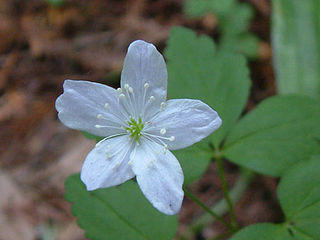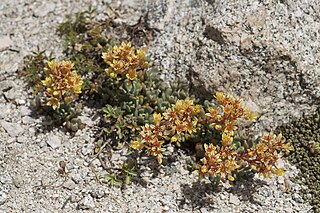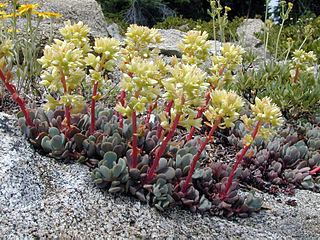
Sedum is a large genus of flowering plants in the family Crassulaceae, members of which are commonly known as stonecrops. The genus has been described as containing up to 600 species, subsequently reduced to 400–500. They are leaf succulents found primarily in the Northern Hemisphere, but extending into the southern hemisphere in Africa and South America. The plants vary from annual and creeping herbs to shrubs. The plants have water-storing leaves. The flowers usually have five petals, seldom four or six. There are typically twice as many stamens as petals. Various species formerly classified as Sedum are now in the segregate genera Hylotelephium and Rhodiola.

Taxodium distichum is a deciduous conifer in the family Cupressaceae. It is native to the southeastern United States. Hardy and tough, this tree adapts to a wide range of soil types, whether wet, salty, dry, or swampy. It is noted for the russet-red fall color of its lacy needles.

Anemonoides quinquefolia, a flowering plant in the buttercup family Ranunculaceae, is native to North America. It is commonly called wood anemone or windflower, not to be confused with Anemonoides nemorosa, a closely related European species also known by these common names. The specific epithet quinquefolia means "five-leaved", which is a misnomer since each leaf has just three leaflets. A plant typically has a single, small white flower with 5 sepals.

Mertensia virginica is a spring ephemeral plant in the Boraginaceae (borage) family with bell-shaped sky-blue flowers, native to eastern North America.

Sedum acre, commonly known as the goldmoss stonecrop, mossy stonecrop, goldmoss sedum, biting stonecrop, and wallpepper, is a perennial flowering plant in the family Crassulaceae. It is native to Europe, but also naturalised in North America, Japan, and New Zealand.

Viburnum trilobum is a species of Viburnum native to northern North America, from Newfoundland west to British Columbia, south to Washington state and east to northern Virginia. It is very closely related to the European and Asian Viburnum opulus, and is often treated as a variety of it, as Viburnum opulus L. var. americanum Ait., or as a subspecies, Viburnum opulus subsp. trilobum (Marshall) Clausen.

Petrosedum rupestre, also known as reflexed stonecrop, Jenny's stonecrop, blue stonecrop, stone orpine, prick-madam and trip-madam, is a species of perennial succulent flowering plant in the family Crassulaceae, native to northern, central, and southern Europe.

Rubus deliciosus is a North American species of flowering plant in the rose family Rosaceae, native to the United States. Common names include the delicious raspberry, boulder raspberry, Rocky Mountain raspberry or snowy bramble.

Taxus floridana, the Florida yew, is a species of yew, endemic to a small area of under 10 km² on the eastern side of the Apalachicola River in mesophytic forests of northern Florida at altitudes of 15–40 m. It is listed as critically endangered. It is protected in reserves at the Torreya State Park and at the Nature Conservancy's Apalachicola Bluffs and Ravines Preserve, and has legal protection under the United States and Florida Endangered Species laws.

Sisyrinchium montanum, the blue-eyed-grass, American blue-eyed-grass, or strict blue-eyed grass, is a grass-like species of plant from the genus Sisyrinchium, native to northern North America from Newfoundland west to easternmost Alaska, and south to Pennsylvania in the east, and to New Mexico in the Rocky Mountains. It has also been introduced to parts of France, likely during the First World War.

Hylotelephium spectabile is a species of flowering plant in the stonecrop family Crassulaceae, native to China and Korea. Its common names include showy stonecrop, iceplant, and butterfly stonecrop.

Sedum sexangulare, also known as tasteless stonecrop, is a species of succulent perennial and evergreen plant of the genus Sedum. It is similar to Sedum acre, but has shorter and denser leaves. It gained the binomial name ("six-angled") for its characteristic six spirals of leaves. S. sexangulare is about 15 cm (5 in) tall and is native to Europe and Asia, where it grows in the wild and is often cultivated as an ornamental plant. The plant needs wet or dry sandy soil and a sunny spot. It blooms in June and July with yellow, star-shaped flowers, which attract bees and other insects.

Sedum lanceolatum is a species of flowering plant in the family Crassulaceae known by the common names spearleaf stonecrop and lanceleaf stonecrop.
Sedum oblanceolatum is a species of flowering plant in the family Crassulaceae known by the common names oblongleaf stonecrop and Applegate stonecrop. It is native to the Klamath Mountains of southwestern Oregon and far northern California, where it grows on many types of rocky substrate, such as serpentine soils and other ultramafics. It is a succulent plant forming basal rosettes of waxy leaves. The leaves are widely lance-shaped, widest near the distal end and narrowing to rounded or notched tips. Smaller leaves occur farther up the stem. The small inflorescence grows a few centimeters tall and bears up to 50 flowers in a flat-topped array. The flowers have cream or yellowish petals up to a centimeter long.

Sedum obtusatum is a species of flowering plant in the family Crassulaceae known by the common name Sierra stonecrop. It is native to the Sierra Nevada and adjacent high mountain ranges of California, its distribution extending north into Oregon and east into Nevada. It grows in rocky mountain habitat.

Sedum oregonense is a species of flowering plant in the family Crassulaceae known by the common name cream stonecrop. It is native to the Klamath Ranges of southern Oregon and northern California, where it grows in rocky habitat. It is a succulent plant forming basal rosettes of leaves up to about 4 centimeters long. Smaller leaves occur farther up the stem. The leaves are green in color and waxy in texture. The inflorescence is an erect, wide open array of many flowers. The flowers have yellow petals with red-tinged or white-speckled undersides.

Sedum spathulifolium is a species of flowering plant in the family Crassulaceae known by the common names broadleaf stonecrop, yellow stonecrop, and spoon-leaved stonecrop. An evergreen perennial, it is native to western North America from British Columbia to southern California, where it can be found often in shade in many types of rocky habitat in coastal and inland hills and mountains.

Solanum glaucophyllum is a species of plant in the family Solanaceae. It is known as waxyleaf nightshade. It is native to Brazil, Bolivia, Argentina, Paraguay and Uruguay.

Sedum hispanicum, the Spanish stonecrop, is a species of plant in the family Crassulaceae.

Hypericum suffruticosum, known as pineland St. John's-wort, is a species of flowering plant in the St. John's wort family, Hypericaceae. It is native to the Southeastern United States.



















